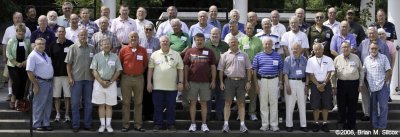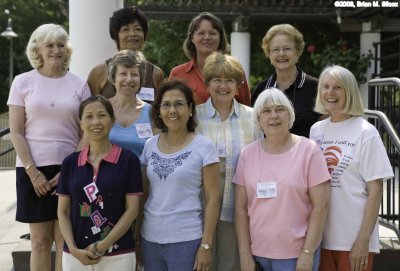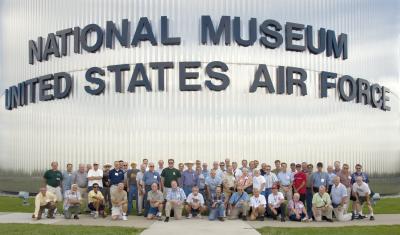
AEHS Convention Highlights 2007-2008
2008 Convention
Report from the 5th Annual AEHS Convention
Sacramento, California (July 9-12, 2008)
by Larry Rinek
Program
 |
| Photo Courtesy of Brian M. Silcox |
It was nice to be able drive my car to attend the 5th annual AEHS convention in the Sacramento area (around two hours from my homestead in Santa Clara). In a first, the convention started early this year on a Wednesday and finished a day early on Saturday. The pre-registered list of attendees (including spouses) numbered 75, but I noticed one ad-hoc late attendee from Sweden on museum day. A natural West Coast bias was noted in the registrations, as was the East Coast bias seen at the 3rd AEHS convention near Hartford, Connecticut (my birthplace) two years ago.
 |
| Many of the ladies explored Sacramento area attractions while convention sessions were ongoing. Photo Courtesy of Brian M. Silcox |
The convention headquarters (Lions Gate Hotel, on premises of former McClellan AFB) was a short distance from the California Aerospace Museum, to be toured on Friday. The attendees were greeted by the pronounced smell of local forest fires plus extreme heat, which reached over 100° during the first two days of the convention, but moderated nicely later.
Supplementing Bill's talk, around noon, the group observed outside on a trailer, an Aerojet LR91 (100,000 lb thrust class) liquid rocket engine, as used for Titan II, III, and IV upper stages, with storable fuel/oxidizer. The compact fuel turbopump on the LR91 was in the 3,000 hp class. The group then enjoyed a buffet lunch hosted by AEHS, followed at 1 PM by Dave Birch's talk on the Merlin: Rolls-Royce versus Packard. Among the many small differences were screw-threads, both UK and US single-stage engines having British threads. All Packard Merlins had US accessories, the single-stage engines having intermediary mounting pads to give a US to UK interface. In the UK this could be removed so that a British accessory could be installed in its place. The Packard had US accessories and the electricals were upgraded from 12 VDC to 24 VDC. The Merlin engineering drawings were completely redone by Packard before production could proceed.
Thursday afternoon (after 2 PM) was devoted to a tour of the famous California Railroad Museum, followed by optional visits to the Delta King riverboat bar and Joe's Crab Shack for dinner. As was the case at the National Museum of the Air Force last year, I found that my digital camera needed to be set in the special "night mode" (with lengthy shutter opening) inside the relatively dark railroad museum to get adequate exposure light, even with flash. As mostly reciprocating "motorheads", the AEHS members had to be impressed with those massive steam-driven piston locomotives at the museum. I have strong boyhood memories of watching large coal-fired steam freight locomotives, the last in revenue service operating in western Pennsylvania, circa 1955-1957.
In the afternoon, the group enjoyed a tour of first the restoration hangar (right on the McClellan flight line, accompanied by many Air Force Reserve live C-130 operations) and then the main museum, including many fine engine exhibits (see full list at http://www.aerospacemuseumofcalifornia.org/engines/), plus the much-anticipated outdoor live demo of Dan Whitney's Allison V-1710 water-cooled V-12 aircraft engine on a custom-built trailer. That particular V-12 engine is configured for 1,500 hp, and runs on 100 LL avgas. What an impressive sight and sound, starting with the profound rocking/shaking on starting when the first few cylinders fired. Dan has an evaporative-cooling spray bar installed on the radiator for high-ambient temperature runs. A number of high-power bursts were experienced, spinning a club prop. A second demo was arranged a short period later. For that run, I was well away walking among the museum's outdoor aircraftexhibits, and even at 100-200 yards the sound was exemplary.
Friday's program concluded with a festive sizable group (including spouses) banquet catered buffet at the museum. This was accompanied by a Dan Whitney slide show on Reno racer pictures.
On Saturday the 21st (9 AM to lunch, conclusion of program) we started with three excellent events hosted by Dave Birch of Rolls-Royce (Dave did yeoman duty at this convention):
The R-R film Contribution to Victory covering design/development/production of the Merlin from the late 1930s to 1945. The plants at Derby, Crewe, and Glasgow were featured. The abundant hand work and meticulous English craft-like processes were quaint. By contrast, in both WWI and in WWII, US aircraft engine plants relied on automotive-type mass production methods with standardized tolerances and less hand labor. R-R plants were full of US-brandedmachine tools, I noticed (as a former machinist's apprentice).
The R-R film of 1993 documenting Trent turbofan certification: although many tests were featured (such as temperature extremes and heavy rain ingestion), the more dramatic tests involved ingestion of a fat 8 lb fresh (not frozen) bird, plus a flock of 8 birds at 1.5 lb each. And then there was the fan-blade-out (FBO) containment test at full power (one wide-chord hollow sheet titanium superplastic-formed fan blade was explosively separated). The entire turbofan engine was trashed via flames, flying metal, and remarkable fury from entry to exhaust, with a resultant wobbling main rotor at the conclusion! What extreme engine violence and destruction to witness! R-R passed the test.
A Dave Birch overview of R-R aero piston engines ranging from the Eagle V-12 with individual cylinders (first aero engine of own design, work started in 1914), through the racing R, the Merlin, the Griffon, and so many others, to the advanced (and very loud) Crecy 2-stroke stratified-charge engine with direct gasoline injection (in development 1941-1945) to the last throw: the Penine "X" sleeve-valve engine of 2,800 hp. Dave reported that 190,000 R-R aero pistonengines were built over the years, including licensee production.
AEHS's convention venue in 2009 is not settled, but a number of candidates were surfaced and audience preferences were recorded. Also debated were alternative months, such as May to October, with September excluded (Reno conflict), possible return to July Oshkosh proximity. All together, it wasanother outstanding gathering this year, and so close to my home.
2008 Convention Sights
Aerospace Museum of California - by Larry Rinek
 |
 |
 |
 |
 |
 |
 |
T.jpg) |
 |
 |
 |
 |
 |
 |
 |
 |
 |
 |
 |
 |
2008 Convention Presentations
NOTICE: Due to abusive robotic downloading of AEHS 2008 Convention presentations by non-members,
Rocket Propulsion Our Key To Space - by William Hoffman |
2007 Convention
Report from the 4th Annual AEHS Convention
Dayton, Ohio (July 19-22, 2007)
by Larry Rinek
Program
 |
| Photo Courtesy of Richard Loftis |
It was my pleasure to fly from San Francisco, California (with one stop in Minneapolis) to attend the 4th AEHS convention in Dayton. The turnout of aeroengine enthusiasts numbered around 75, including two who flew over from Holland.The convention hotel headquarters (Holiday Inn) was on the north side of Dayton right off of I-75, a short distance from the National Museum of the UnitedStates Air Force, the star convention attraction this year. I toured this Air Force museum decades ago, and what a difference today: most aircraft are now displayed inside (formerly weathering outside) and new exhibit halls are now in place, including the recent Cold War hangar housing the truly impressive B-36J giant intercontinental bomber (saw this aircraft fly once as a youngster in Connecticut, in May 1956). As a former USAF officer serving on active duty during the Cold War, and an aviation historian, this museum — with its priceless original aircraft and engine collection, is a rather special place (hallowed ground) for me.
Upon the Thursday July 19 arrival, the group got acquainted inside the hotel with evening drinks and a fine buffet (supposed to be appetizers—but resembled a full luncheon!).
The program got under way early the following morning (Friday 20th) with introductions and then a special guided tour of the restoration shop near the museum on Wright-Patterson AFB. Among other aircraft, the famous Memphis Belle B-17F bomber was in pieces getting a total makeover, as well as the rare Fisher P-75A fighter with contra-rotating props and Allison V-3420 power. The backlog of restoration projects stretches many years out.
Friday's program concluded with a group dinner (optional) at a local RubyTuesday's.
At the end of the buffet luncheon, attendees viewed a most interesting and detailed video concerning the WW II manufacturing of Wright R-3350 radial engines. As a guy formally trained in manufacturing engineering, metalworking, and metallurgy, this subject material was right up my alley. Never knew how radial engine builders nitrided (hardened) those steel cylinde interiors, until the video.
The entire afternoon was allocated to an unguided walking tour (no admission charge) of the museum, preceded by an AEHS convention group photo. Packing a new digital SLR camera, I went wild shooting over 150 images inside and outdoors (no film rolls!). Photographers discovered how difficult it was to get good indoor exposures at the museum even with flash (often too dark), due to the minimal ambient lighting — so many shots were deleted. I went back and had to re-shoot many in a special "night mode" (shutter open a long time) with better results — ift he camera was still. Many engines (piston, gas turbine, rocket), were on display — too many to list here. One of the more unique engines was a 1918 experimental high-output Liberty V-12 (a Lincoln conversion) with turbocharging, intercooling, and gear reduction to the prop shaft (way ahead of its time, not reliable).
Lee Hodgson, former P&W test engineer (East Hartford CT, where my father worked 1941-1945) and notable scale-model radial and rotary aero engine builder, was the well-received after-dinner speaker for the annual banquet on Saturday night. Kudos to Lee and his wife Peggy who helped host this year's event in Ohio, doing much of the advance prep work—such as securing the convention hotel.
AEHS's most likely convention venue in 2008 is on the "left coast" (finally, for the many members like myself out there), either in Southern or Northern California. All together, an outstanding gathering this year, and attendance was up over 2006.
2007 Convention Sights
National Museum of the United States Air Force - by Tony Ward
2007 Convention Presentations
NOTICE: Due to abusive robotic downloading of AEHS 2007 Convention presentations by non-members,
Establishing a New Engine Museum - by Dave Newill |